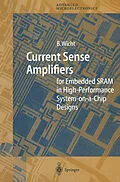This book provides a systematic and comprehensive insight into current sensing techniques. In addition to describing theoretical and practical aspects of current sensing, the author derives practical design guidelines for achieving an optimal performance through a systematic analysis of different circuit principles. Voltage sense amplifiers are also considered, since they are used as a final comparator in a current sense amplifier. Innovative concepts, such as compensation of the bitline multiplexer and auto-power-down, are elucidated. Although the focus is on embedded static random access memory (SRAM), the material presented applies to any current-providing memory type, e.g. also to emerging memory technologies such as MRAM. The book will appeal to design engineers in industry and also to researchers wishing to learn about, and apply, current sensing techniques.
Klappentext
System-on-a-chip (SoC) designs result in a wide range of high-complexity, high-value semiconductor products. As the technology scales towards smaller feature sizes and chips grow larger, a speed limitation arises due to an in creased RC delay associated with interconnection wires. Innovative circuit techniques are required to achieve the speed needed for high-performance signal processing. Current sensing is considered as a promising circuit class since it is inherently faster than conventional voltage sense amplifiers. How ever, especially in SRAM, current sensing has rarely been used so far. Practi cal implementations are challenging because they require sophisticated analog circuit techniques in a digital environment. The objective of this book is to provide a systematic and comprehen sive insight into current sensing techniques. Both theoretical and practical aspects are covered. Design guidelines are derived by systematic analysis of different circuit principles. Innovative concepts like compensation of the bit line multiplexer and auto-power-down will be explained based on theory and experimental results. The material will be interesting for design engineers in industry as well as researchers who want to learn about and apply current sensing techniques. The focus is on embedded SRAM but the material presented can be adapted to single-chip SRAM and to any other current-providing memory type as well. This includes emerging memory technologies like magnetic RAM (MRAM) and Ovonic Unified Memory (OUM). Moreover, it is also applicable to array like structures such as CMOS camera chips and to circuits for signal trans mission along highly capacitive busses.
Inhalt
1. Introduction.- 2. Fundamentals of SRAM and Sensing.- 3. Voltage Sense Amplifiers.- 4. Circuit Principles for Current Sensing.- 5. Analysis and Compensation of the Bitline Multiplexer.- 6. Interaction with the Memory Cell.- 7. Implementation Aspects.- 8. Outlook.- A. Two-Pole Transfer Function.- B. Step Response.- C. Common-Mode Stability.- D. Delay Versus Supply Voltage.- E. Experimental Results: Current Sensing.- F. Experimental Results: Voltage Sensing.
